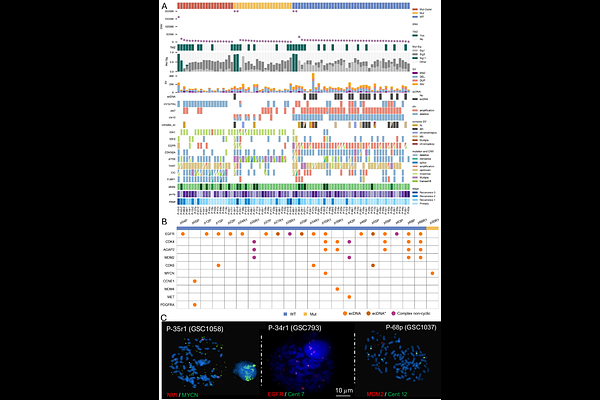Oncogenic drivers shape the tumor microenvironment in human gliomas

Oncogenic drivers shape the tumor microenvironment in human gliomas
Zhao, B.; Cho, C. Y.; Ye, L.; Keal, T.; Mitchell, T. J.; Martin-Barrio, I.; Weinberg, J. S.; Huse, J. T.; Dixon, J. R.; Lang, F. F.; Akdemir, K. C.
AbstractGliomas are aggressive and heterogeneous brain tumors with limited treatment options. While oncogenic mutations in gliomas have been well-characterized, their impact on the tumor microenvironment remains poorly understood. To investigate how genomic alterations may influence the glioma microenvironment, we performed an integrative multiomic and spatial transcriptomic analysis of 93 glioma samples (46 IDH-mutant gliomas and 47 IDH-wildtype glioblastoma) from 69 patients representing both primary and recurrent stages. Using whole-genome sequencing, chromatin conformation capture (Hi-C), RNA-seq, and single-cell spatial transcriptomics (Xenium), we defined how major driver mutations influence spatial tumor organization. We found that IDH-mutant gliomas frequently harbored inflammatory microglia expressing CX3CR1 specifically within their astrocyte-like malignant neighborhoods. In contrast, glioblastomas demonstrated relatively higher T-cell infiltration and enrichment of immunosuppressive myeloid cell populations. We further compared glioblastomas harboring EGFR amplifications due to extrachromosomal DNA (ecDNA) amplifications versus linear chromosomal 7 gains. Tumors with EGFR ecDNA displayed increased presence of mesenchymal-like malignant cells, and higher interactions between pericytes and mesenchymal-like malignant cells, likely driven by hypoxia-associated vascular proliferation. Our findings reveal that the mode of oncogene amplification (linear versus ecDNA) shapes distinct tumor architectures and transcriptional dynamics. Taken together, our study highlights the role of oncogenic drivers in shaping the glioma microenvironment, revealing subtype-specific cellular ecosystems that could inform targeted therapeutic strategies.